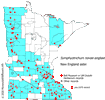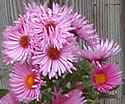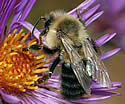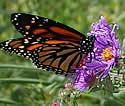Symphyotrichum novae-angliae (New England Aster)
| Also known as: | |
|---|---|
| Genus: | Symphyotrichum |
| Family: | Asteraceae (Aster) |
| Life cycle: | perennial |
| Origin: | native |
| Habitat: | part shade, sun; moist fields, along roads, edges of woods |
| Bloom season: | August - October |
| Plant height: | 3 to 7 feet |
| Wetland Indicator Status: | GP: FACW MW: FACW NCNE: FACW |
| MN county distribution (click map to enlarge): |  |
| National distribution (click map to enlarge): |  |
Pick an image for a larger view. See the glossary for icon descriptions.
Detailed Information
Flower: 

![[photo of flowers]](/udata/r9ndp23q/purple/symphyotrichum-novae-angliae-new-england-aster_0920_112442-t.jpg) Branching clusters of stalked flowers at the top of the stem and arising from upper leaf axils. Branches are often leafy and crowded with flowers. Flowers are 1 to 1½ inches across with 40 to 100 narrow petals (ray flowers) and a golden yellow center that turns reddish purple with age. Ray color is purple to rose pink.
Branching clusters of stalked flowers at the top of the stem and arising from upper leaf axils. Branches are often leafy and crowded with flowers. Flowers are 1 to 1½ inches across with 40 to 100 narrow petals (ray flowers) and a golden yellow center that turns reddish purple with age. Ray color is purple to rose pink.
![[photo of bracts (phyllaries)]](/udata/r9ndp23q/purple/new-england-aster-100_5155-t.jpg) The bracts (phyllaries) surrounding the base of the flower are in 3 to 5 layers, very narrow, green to purple-tinged, widely spreading, and the outer phyllaries covered in short glandular hairs. Flower stalks are up to 1½ inch long with a few narrow, leaf-like bracts below the flower. Stalks and bracts are covered in a mix of glandular and nonglandular hairs.
The bracts (phyllaries) surrounding the base of the flower are in 3 to 5 layers, very narrow, green to purple-tinged, widely spreading, and the outer phyllaries covered in short glandular hairs. Flower stalks are up to 1½ inch long with a few narrow, leaf-like bracts below the flower. Stalks and bracts are covered in a mix of glandular and nonglandular hairs.
Leaves and stem: 

![[photo of leaves]](/udata/r9ndp23q/purple/new-england-aster-100_5152-t.jpg) Leaves are mostly lance-oblong, some widest above the middle, 1 to 4 inches long, ½ to 1 inch wide, mostly toothless, stalkless, tapering to a pointed or rounded tip, the base with a pair of lobes (auricles) that extend around the stem and clasp it. The upper surface is rough; the underside more softly hairy. Basal leaves are more spatula-shaped and wither away by flowering time along with the lower stem leaves; upper stem leaves are often densely packed. Stems are single or multiple from the base, mostly erect, stout, brown to reddish, and covered in short, spreading hairs
Leaves are mostly lance-oblong, some widest above the middle, 1 to 4 inches long, ½ to 1 inch wide, mostly toothless, stalkless, tapering to a pointed or rounded tip, the base with a pair of lobes (auricles) that extend around the stem and clasp it. The upper surface is rough; the underside more softly hairy. Basal leaves are more spatula-shaped and wither away by flowering time along with the lower stem leaves; upper stem leaves are often densely packed. Stems are single or multiple from the base, mostly erect, stout, brown to reddish, and covered in short, spreading hairs
Fruit: 
![[photo of seed]](/udata/r9ndp23q/pd/symphyotrichum-novae-angliae-2-t.jpg) Fruit is a dry, hairy seed with a tuft of light brown hairs to carry it off in the wind.
Fruit is a dry, hairy seed with a tuft of light brown hairs to carry it off in the wind.
Notes:
New England Aster is an important late-season food source for pollinators, blooming through October and even into November. Plant it in your garden and it's guaranteed you'll have a pollinator party until the last flower is wilted away. The flowers are easily distinguished from other blue-violet asters by the numerous narrow, purple rays (up to 100), golden yellow disk, and widely spreading narrow phyllaries. The leaves are vaguely similar to Purple-stemmed Aster (Symphyotrichum puniceum), which tend to have a longer taper to a sharply pointed tip and usually have a few small teeth around the edge.
Native Plant Nurseries, Restoration and Landscaping Services ↓
More photos
 New England Aster plant
New England Aster plant New England Aster plants
New England Aster plants garden-grown New England Aster
garden-grown New England Aster pink-flowered New England Aster
pink-flowered New England Aster New England Aster pollinator
New England Aster pollinator New England Aster pollinator
New England Aster pollinator
Photos by K. Chayka taken in Anoka, McLeod and Ramsey counties. Photos courtesy Peter M. Dziuk taken in private gardens in Anoka and Ramsey counties.
Comments
Have you seen this plant in Minnesota, or have any other comments about it?
on: 2010-09-06 21:18:48
This is a good, colorful fall bloomer, with occasional pale pink flowers along with the usual purple or rose-pink. It can become aggressive, and volunteers sprout readily in the garden. Bees love the flowers and birds love the seeds.
on: 2014-09-28 12:22:24
I've seen many of these along the road ditches and meadows in the last month (september)
on: 2017-09-17 19:53:35
These are abundant here along Cross Lake Road outside of Pine City, though I see they are not shown for Pine County on the distribution map.
on: 2017-09-18 07:46:10
I have a big clump of these this year.
on: 2017-10-10 10:51:08
What does this look like during the spring-summertime? Pictures please Is it easy to keep under controll?
on: 2018-05-30 14:33:49
Grows and spreads well. Really attracts bees. In the spring, it is short green, growing quickly to tall green, them blooms in September. If you don't want it to take over, you will need to thin it out. I have at least four shades of flowers, from dark purple to light pink. Great for hiding things.
on: 2019-09-20 16:54:33
Have these in my rain garden in Cambridge MN. I have numerous bunches and they bloom from late August through the end of September. I have transplanted some to the bioretension garden at Christ the King Church, Cambridge MN.
on: 2020-09-22 19:29:59
I love these asters. I have a profusion of yellows, yellow whites/purples. Some flowers have bigger flowers. They really color the Fall season and pollinators love them!
on: 2020-09-25 19:26:31
Moved into a new subdivision in 2017 and Rosemount built a new City park playground nearby. I am guessing they may have seeded the natural edges of the park with native wildflower seeds as this purple aster as well as other native wildflowers are growing nicely in the disturbed edges of the park.






